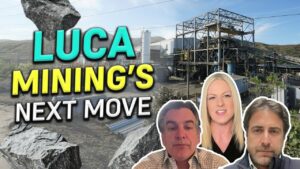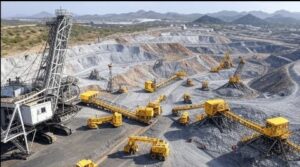Vancouver, April 17, 2012 – Baja Mining Corp. (TSX:BAJ – OTCQX: BAJFF) today announced that Gerald Prosalendis has resigned from the Board of Directors for personal and family reasons.
“I wish Baja and the Board continued success as I pursue other interests,” said Mr. Prosalendis.
The Board thanks Mr. Prosalendis for his efforts on behalf of Baja.
About Baja
Baja Mining Corp. (TSX:BAJ-OTCQX:BAJFF) is a mine development company with a 70 percent interest in the Boleo copper-cobalt-zinc-manganese Project located near Santa Rosalia, Baja California Sur, Mexico. Baja is the project operator and a Korean syndicate of industrial companies holds the remaining 30 percent. Boleo is funded, currently under construction and targeted for copper commissioning in 2012, and copper production in early 2013. Boleo has 265 Mt of measured and indicated resources (including 85 Mt of proven and probable reserves) and 165 Mt of inferred resources. A March 2010 updated technical report to the 2007 definitive feasibility study, confirmed that Boleo could be developed economically at an after-tax IRR of 25.6 percent (100 percent equity), with a minimum scheduled mine life of 23 years (during which approximately 70 Mt of the noted proven and probable reserves will be exploited), a NPV of US$1.3 billion (8 percent discount rate), and an average life-of-mine cash cost of negative US$0.29/lb for copper, net of by-product credits. Metal Prices were based on SEC pricing guidelines (which at the time of the 2010 report were US$2.91/lb Cu, US$26.85/lb Co and US$1,175/tonne ZnSO4H2O). For more information, please visit www.bajamining.com.
On behalf of the Board of Directors of Baja Mining Corp.
“John W. Greenslade”
John W. Greenslade, President & Chief Executive Officer
For further information please contact Kendra Low, Vice President Administration & Corporate Secretary, at 604-685-2323.
Forward-Looking Statements
This news release contains forward-looking statements. Forward-looking statements are statements that relate to future events or financial performance, anticipated developments at the Company’s projects and the projected performance and economics of the Boleo Project. In addition, estimates of mineral reserves and resources and NPV estimates may be forward-looking statements because they represent estimates of mineralization, costs, revenues and other factors that may be encountered in the future. Forward-looking statements speak only as of their date, are only predictions and are subject to known and unknown risks, uncertainties and other factors, including without limitation those described in Baja’s most recent annual information form filed under its profile at www.sedar.com and its most recent annual report filed with the US Securities and Exchange Commission (“SEC”) at www.sec.gov. All forward-looking statements in this news release are qualified by these cautionary statements. These risks, as well as risks that the Company cannot currently anticipate, could cause the Company’s or its industry’s actual results, levels of activity or performance to be materially different from any future results, levels of activities or performance expressed or implied by these forward-looking statements. Although the Company believes that the expectations reflected in the forward-looking statements included in this press release are reasonable, the Company cannot guarantee future results, levels of activity or performance. Except as required by applicable law, the Company does not intend to update any of these forward-looking statements to conform them to actual results.
Cautionary Note Regarding References to Resources and Reserves
National Instrument 43 101 – Standards of Disclosure for Mineral Projects (“NI 43-101”) is a rule developed by the Canadian Securities Administrators which establishes standards for all public disclosure an issuer makes of scientific and technical information concerning mineral projects. Unless otherwise indicated, all reserve and resource estimates contained in this press release have been prepared in accordance with NI 43-101 and the guidelines set out in the Canadian Institute of Mining, Metallurgy and Petroleum (the “CIM”) Standards on Mineral Resource and Mineral Reserves (the “CIM Standards”).
United States shareholders are cautioned that the requirements and terminology of NI 43-101 and the CIM Standards differ significantly from the requirements and terminology of the SEC set forth in the SEC’s Industry Guide 7 (“SEC Industry Guide 7”). Accordingly, the Company’s disclosures regarding mineralization may not be comparable to similar information disclosed by companies subject to SEC Industry Guide 7. Without limiting the foregoing, while the terms “mineral resources”, “inferred mineral resources”, “indicated mineral resources” and “measured mineral resources” are recognized and required by NI 43-101 and the CIM Standards, they are not recognized by the SEC and are not permitted to be used in documents filed with the SEC by companies subject to SEC Industry Guide 7. Mineral resources which are not mineral reserves do not have demonstrated economic viability, and US investors are cautioned not to assume that all or any part of a mineral resource will ever be converted into reserves. Further, inferred resources have a great amount of uncertainty as to their existence and as to whether they can be mined legally or economically. It cannot be assumed that all or any part of the inferred resources will ever be upgraded to a higher resource category. Under Canadian rules, estimates of inferred mineral resources may not form the basis of a feasibility study or prefeasibility study, except in rare cases. The SEC normally only permits issuers to report mineralization that does not constitute SEC Industry Guide 7 compliant “reserves” as in-place tonnage and grade without reference to unit amounts. In addition, the NI 43-101 and CIM Standards definition of a “reserve” differs from the definition in SEC Industry Guide 7. In SEC Industry Guide 7, a mineral reserve is defined as a part of a mineral deposit which could be economically and legally extracted or produced at the time the mineral reserve determination is made, and a “final” or “bankable” feasibility study is required to report reserves, the three-year historical price is used in any reserve or cash flow analysis of designated reserves and the primary environmental analysis or report must be filed with the appropriate governmental authority.

















